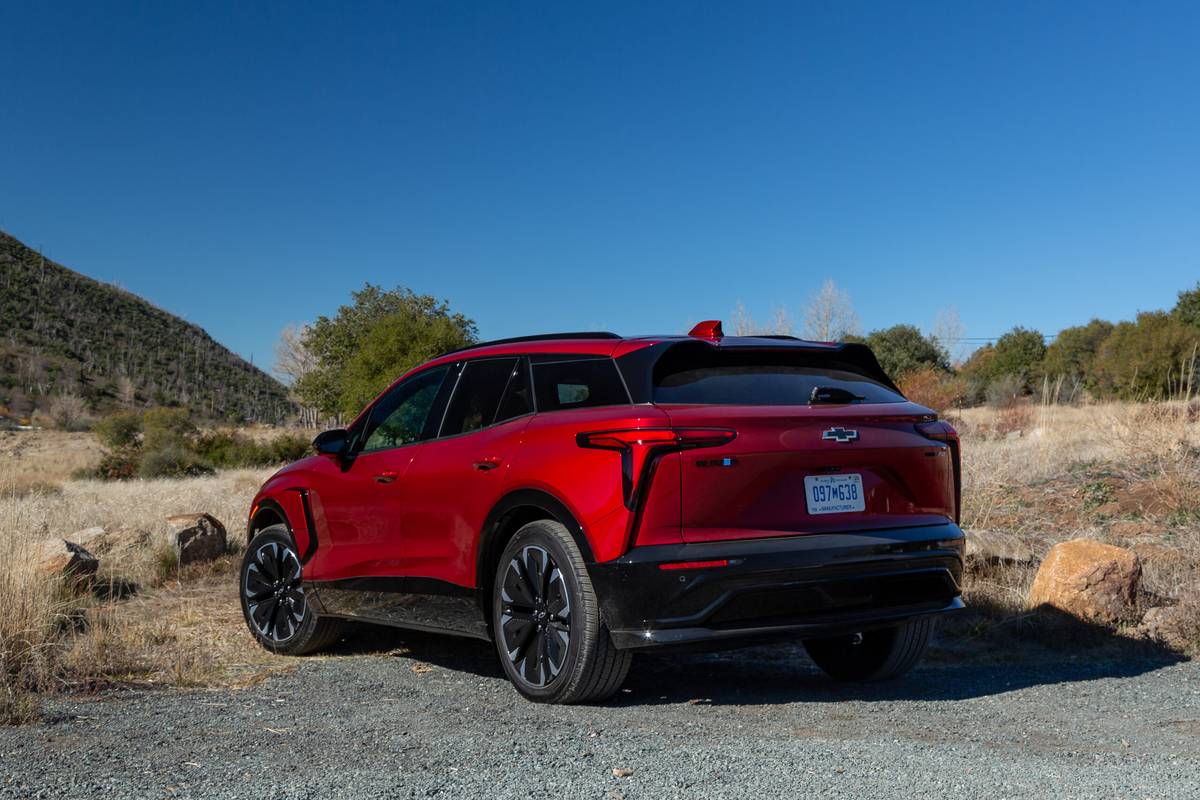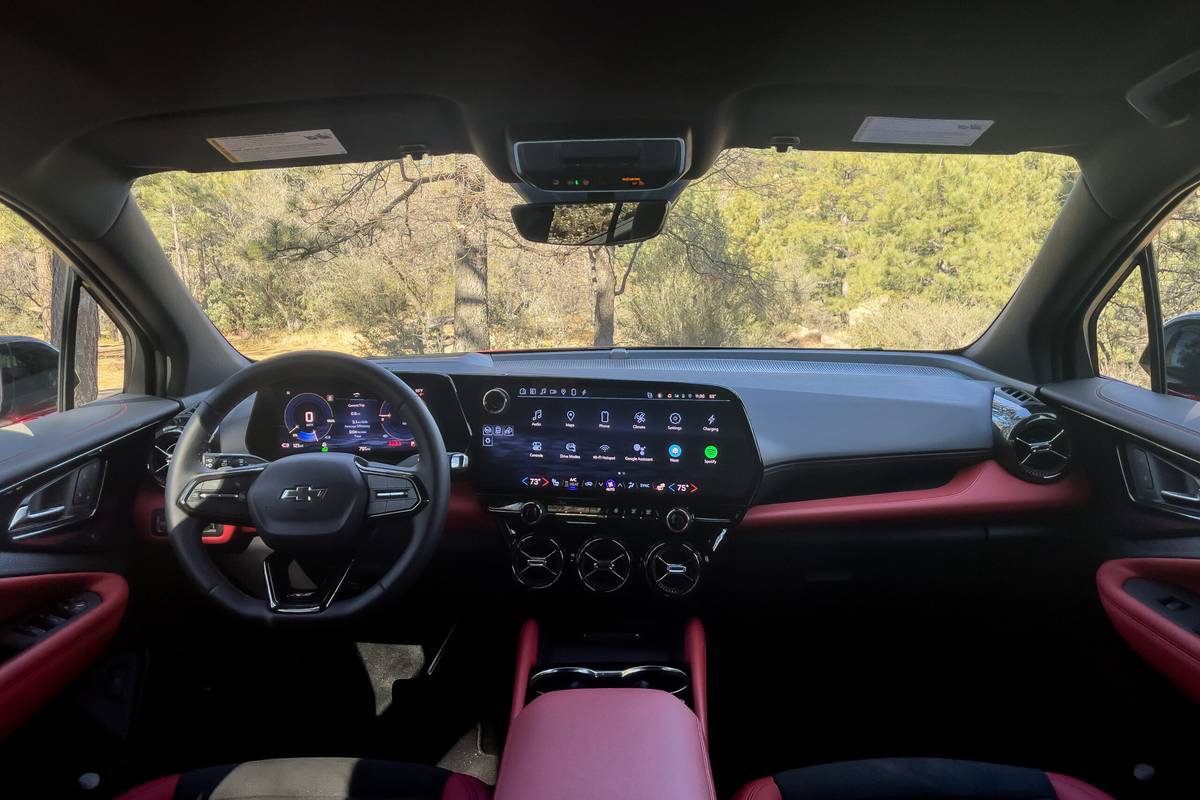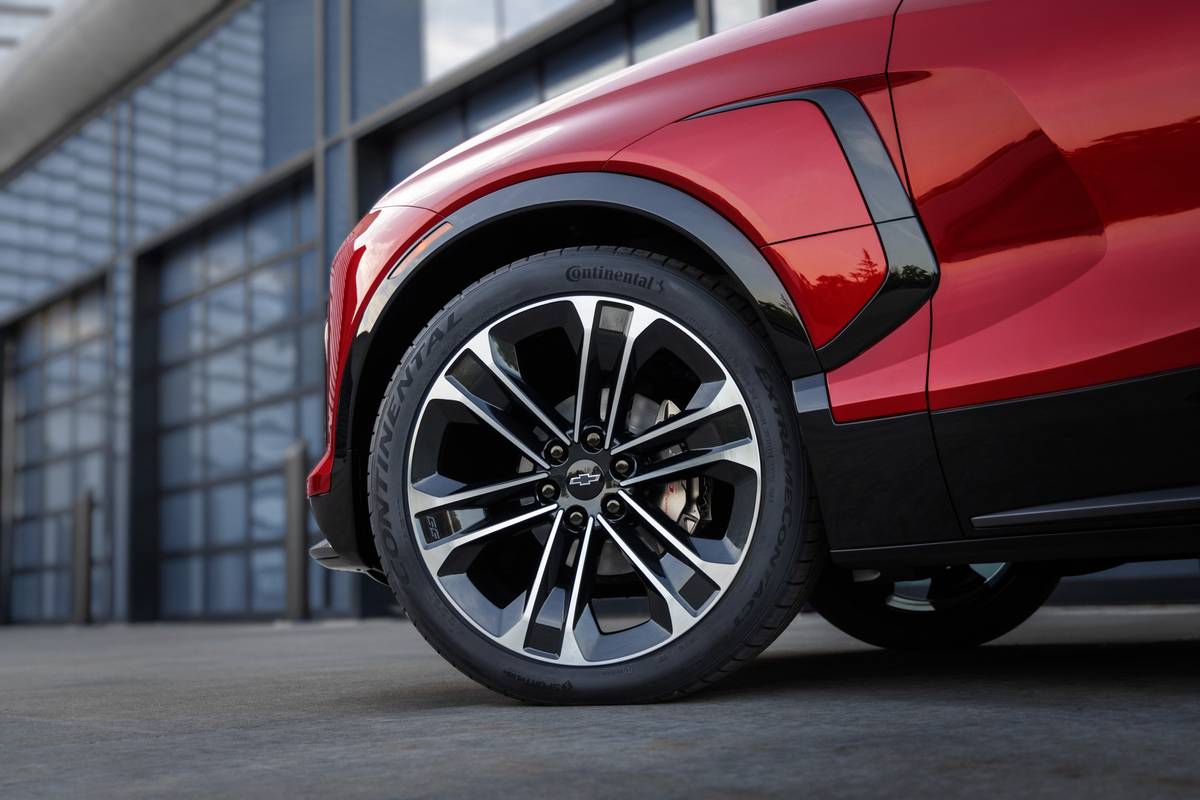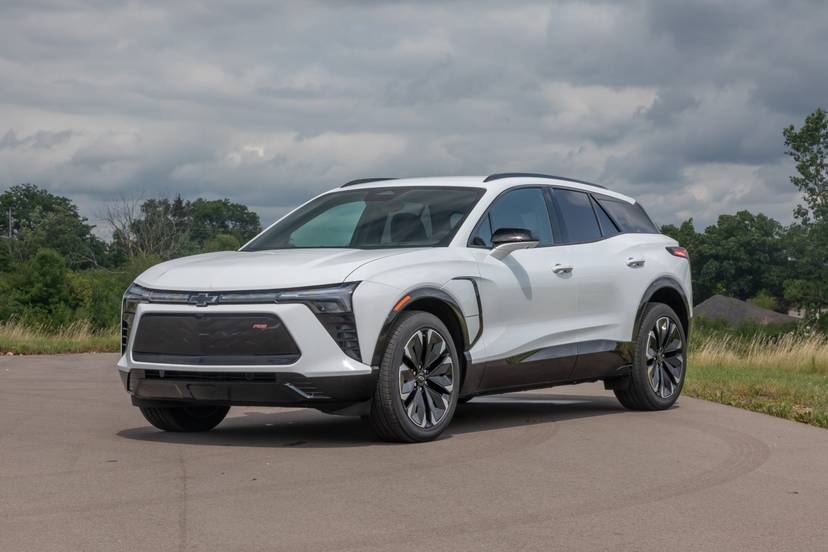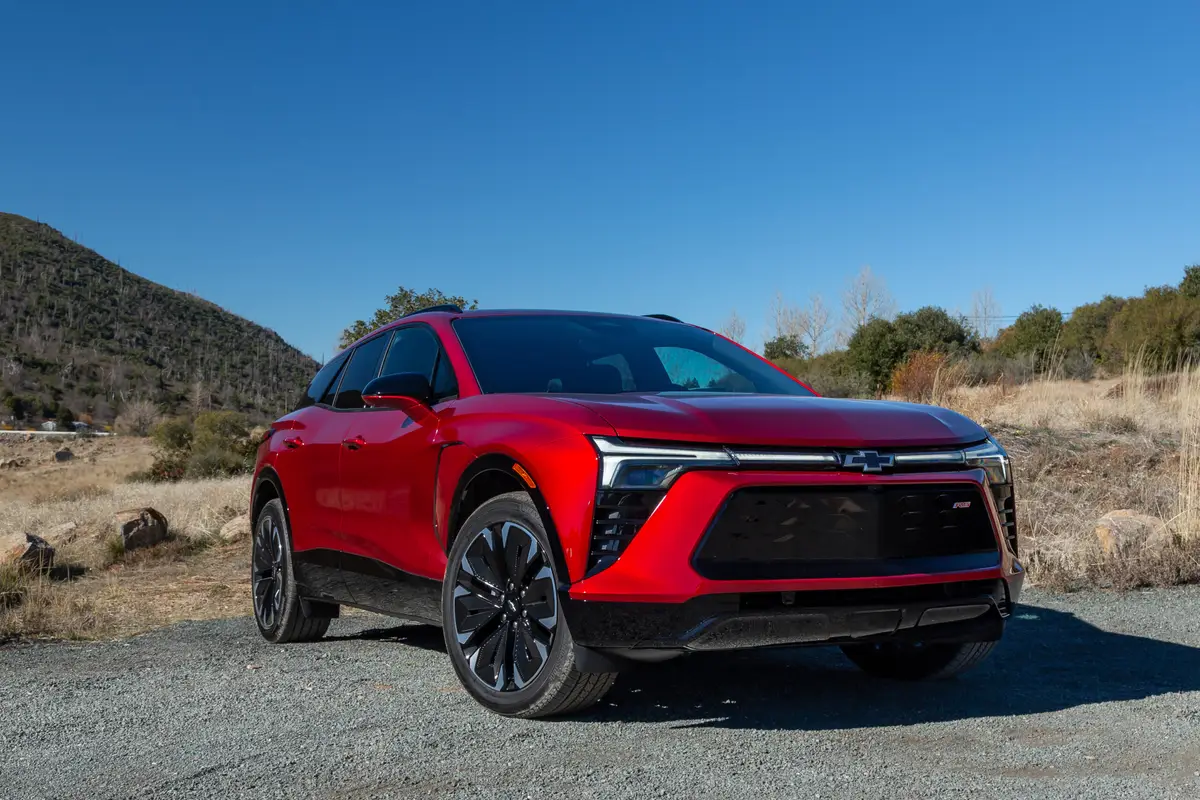
The verdict: The all-electric 2024 Chevrolet Blazer EV looks sharp, drives sharper, and arrives with highly competitive range and fast-charging capability, but its sky-high pricing has it encroaching into Cadillac’s territory and risks it being upstaged by the cheaper Equinox EV.
Versus the competition: An upmarket interior, beefy range, impressive infotainment system and surprising handling bring the fight directly to other premium EV mid-sizers.
Here’s something (potentially) unprecedented: When production is in full swing, buyers can outfit the all-new 2024 Chevrolet Blazer EV with their choice of front-, rear- or all-wheel drive. According to Chevy, this means there’s a Blazer EV for everyone, citing the new electric mid-size SUV’s wide market flexibility. We’ve seen nary a photo nor even a spec sheet of the forthcoming front-motor, front-wheel-drive model — Chevy aims for a launch by the 2025 model year — but the brand promises it will be the most affordable iteration.
Related: Chevrolet Updates 2024 Blazer EV Pricing, Timelines
There seems to be no rush for this base model, as the potent dual-motor Blazer EV SS blitzes into dealers come spring. For now, early buyers have their choice of either the rear-motor RWD or dual-motor AWD Blazer EV.
At Chevrolet’s invitation, we spent two days in the Blazer EV buzzing around Southern California’s byways and highways, finding the Bow-Tie’s latest EV to be a stylish, feature-rich crossover whose impressive build quality and refinement belie its badge, but not its price. (Cars.com pays for its own lodging and travel when attending manufacturer-sponsored events.)
All the Go
As part of Chevrolet parent automaker GM’s multifarious BEV3 platform, all Blazer EVs pull power from GM’s Ultium battery technology and share drivetrain tech with the Cadillac Lyriq and forthcoming Chevrolet Equinox EV. Think of the zappy Blazer as Chevy’s analog to the Lyriq, sharing the same 121.8-inch wheelbase and (in some configurations) battery pack.
Even for this rather complex class, breaking down the powertrain differences and available options between the Blazer EV’s trims ties quite the Gordian knot. The base 2LT and mid-range RS models both will be available with the dual-motor AWD setup. As equipped, those variants carry an 85-kilowatt-hour battery good for a competitive 279 miles of EPA-estimated range and 150-kilowatt DC fast charging that recoups “around” 69 miles of range in 10 minutes, albeit from an unspecified starting state of charge.
Notice we’re specifying 2LT rather than 1LT. As part of Chevrolet’s reassessment of EV market demand, it decided to drop the $45,000 1LT in favor of the better-equipped 2LT. Regardless of trim, the dual-motor eAWD variant is rated at a combined 288 horsepower and 333 pounds-feet of torque, enough for a claimed 6.0-second 0-60 mph scoot. Not the pavement-folding barn-burner you were hoping for? It helps to think of the eAWD system as an EV equivalent to FWD-based AWD systems found on gas-powered SUVs like the Honda CR-V and Nissan Rogue, where clutch packs and differentials route some power to the rear some of the time — usually when loss of traction is detected or a specific weather-oriented drive mode is engaged. Apply this line of thought to the Blazer EV with eAWD: Unlike the twin permanent-magnet motors in the Blazer EV SS, the rear unit in the eAWD is a conventional induction motor that, much like the previously mentioned gas SUV AWD systems, engages in spurts. It’s for light (and we do mean light) off-roading, winter roads and moments of slippage that might occur during some curved-road shenanigans. For most driving scenarios, the eAWD’s larger front-mounted permanent-magnet motor handles propulsion.
Unique to the RS is the rear-drive configuration, offered only with the larger 102-kWh battery capable of a manufacturer-estimated 324-mile range and DC fast charging up to 190 kW. Under ideal fast-charging conditions, Chevrolet claims 78 miles of range is added in around 10 minutes. As the most performative setup outside of the habanero-hot SS, the RWD’s permanent magnet motor shreds the rear tires with 340 hp and 325 pounds-feet, dropping the 0-60 mph scramble to a quick 5.5 seconds.
All the Show
I drove the RWD and AWD drivetrains, both in RS trim. As is historically the case, Chevrolet’s RS badge is exclusively stylistic and designatory of equipment. A pair of stationary 2LTs populated our base camp for the first drive day, giving us a good look of what to expect. We’re not here to levy judgment on the subjective, but we much preferred the contrasted black accents of the RS — particularly the lower, center portion of the grille — to the 2LT’s rather rental-fleet appearance.
Still, even the 2LT will stand out in a sea of Equinoxes and Traverses. Battery and motor packaging allow aggressively short overhangs at both ends, with wide track and a raked roofline that recalls more than a whiff of the handsome Kia EV6. It’s a visually striking car, particularly in iridescent Galaxy Gray Metallic paint.
Driveline guts up front prevent the inclusion of an ever-useful frunk, but Chevy claims its 59.1 cubic feet of maximum cargo space behind the front seats is best in the segment, even if it trails the regular gas-powered Blazer’s maximum 64.2 cubic feet of storage. For daily detritus like phones, sunglasses, gum, pepper grinders and instant-oatmeal packets, all Blazer EVs are cleverly outfitted with three cavernous cubbies in the front of the cabin; aside from the standard storage under the center armrest, a retracting panel under the center controls hides a deep cubby with another stowage space extending under the dash.
Tech Titan
Outside of storage, the Blazer EV’s cabin in RS trim is markedly upscale for the brand, matched and exceeded only by uplevel trims of the Suburban, Tahoe and Silverado. Trim plastics are both soft-touch and mostly textured with contrasting patterns, with portions of the air vents and dash encapsulated in glossy red metallic plastic that both conveys visual depth and serves to elevate the space. In the RS, direct touchpoints are pseudo-premium, with a leather-wrapped steering wheel and Evotex upholstery extended throughout the cabin, the latter being GM’s trademarked synthetic material that’s spill-, stain- and wear-resistant.
But this is all tinsel compared to the Blazer EV’s showcase infotainment tech. The Blazer’s standard 17.7-inch center touchscreen is impressive; its operation speed, resolution and thin-framed edges are more impressive than screens found on far more expensive cars. Aside from the standard home screen menu, some controls (e.g., regenerative braking, drive modes and power-off toggle) could be pinned to the side closest to the driver for easy access during full-screen navigation usage. The 11-inch driver display was no less impressive, with similar levels of resolution and customization.
This is GM’s first vehicle to fully eschew the popular Apple CarPlay and Android Auto smartphone connectivity, instead relying on Google’s new comprehensive infotainment suite that’s recently wormed its way into a number of automakers’ lineups, including Honda and Volvo. While you won’t be able to project your smartphone onto that gorgeous display, GM (and Google) are betting you won’t care with the range of available apps offered with Google Built-In. The most significant is the integration of Google Maps, where unlike most — if not all — of the automaker’s in-house navigation systems, you can search for a destination, address, point of interest or local establishment as you would on your mobile app. It’s fast and fairly seamless, and smartly suggests alternative routes and stopovers to maximize range efficiency and minimize charging downtime. Other features are less crucial, including voice commands and specialized apps for Spotify and YouTube.
It works well in practice, but we’re not convinced customers are going to be as pleased as GM’s coffers; aside from removing one of the most popular and user-friendly automotive features in recent memory, this is a clear move by GM to access driver’s data, along with filling a new subscription war chest that will amount to $20 billion to $25 billion in annual revenue by 2030, according to CEO Mary Barra.
Blazing a Trail
Once you’ve stopped fiddling with all that screen real estate, it’s time to, y’know, drive. Chevrolet opted for keyless ignition in the most literal sense; using weight sensors in the seat and corresponding key proximity sensors, the Blazer EV wakes to drive-ready state with two pumps of the brake pedal. There is no start-stop button, though there is a power-down toggle on the center screen alongside an “extend” function that allows the climate control to function for pets while you’re grabbing groceries.
Like the overwhelming majority of EVs currently on the market, the Blazer EV’s operation is easy, light and utterly digital. Normal driving returns an experience not unlike a regular conventionally powered crossover sans any noise vibration and harshness from a gas burner up front. In place of engine noise is Chevy’s take on the requisite space-age EV soundtrack, a whirring thrum that wouldn’t be out of place in the engine room of a Star Destroyer.
All 2LT and RS Blazer EVs ride on fixed steel springs, so drive mode changes extend to steering weight, accelerator pedal response and that pumped-in motor sound. Ride quality is well damped for its curb weight, with the RWD model returning the most jostle and judder. Whether this comes down to revised spring rates for the larger battery, the lack of a front motor or additional stiffness for performance, it wasn’t harsh enough nor distinct enough from the eAWD to cause concern.
Steering is slower than I would have liked, primarily during low- to moderate-speed maneuvers, but push the Blazer EV even a smidge and you’ll quickly find that its low center of gravity pays sizable dividends when the road turns squiggly. Mechanical grip is impressive for the class even if it’s somewhat irrelevant given the Blazer EV’s intended use as a workaday crossover. But, with capability comes confidence, and those dragging the family up to the mountain cabin will enjoy its surefootedness.
Neither powertrain shocked with speed and performance, but both were sprightly enough to match on-ramp pace with a hot hatchback and pass lumbering semitrailers safely. Drives in the RWD model were too short to drain the battery beyond the 75% mark, but our extended run in the eAWD revealed a noticeable drop in performance when battery charge dipped beneath the halfway point. On that: Range with either battery is near the top of the class, and despite aggressive, greedy go-pedal application during our 150-mile route, the EPA-estimated range appears to be dead on.
It was the brake blending that impressed most. The stopping power of Chevy’s two-level regenerative braking system was great enough for easy one-pedal driving, and both modes provided enough drag to bring the car down to a crawl if timed correctly. Excellent brake-blend tuning allows the SUV to come to a full stop, occupants none the wiser that there was a hand-off between braking systems.
More From Cars.com:
- Up Close With the 2024 Chevrolet Blazer EV: Hitting the Sweet Spot for Sporty EVs
- 2024 Chevrolet Blazer EV: Chevy Delivers a Mustang Mach-E Killer
- What to Know Before Purchasing an Electric Vehicle: A Buying Guide
- Electric Cars With the Longest Range
- Shop for a 2024 Chevrolet Blazer EV
Should You Buy One?
Taken in a vacuum, the 2024 Blazer EV is an impressive and cohesive electric SUV with distinctive aesthetics; an upscale interior; and highly competitive range, charging and infotainment tech. It’s only Chevy’s moonshot pricing that keeps us at plug’s length, with the cheapest (for now) 2LT eAWD starting at a stunning $56,715 (all prices include destination charge). Amusingly, the $61,790 RS RWD costs more than the RS eAWD’s $60,215 sticker price, a wacky happenstance Chevy reps ascribed to the RWD’s larger battery.
Surprisingly, it’s not outside competition that spooks us the most at this price, it’s Cadillac’s call from inside the house that makes the whole endeavor a bit odd. For a little less than the Blazer EV RS RWD, you can have a base 2024 Lyriq Tech ($58,590) with the same battery, motor and power, better materials, a better badge and a 33-inch wraparound infotainment screen. The gulf widens when you jump to the dual-motor Lyriq Luxury: For $62,090 to start, you get all the standard features on the RWD Caddy, but power leaps to a very impressive 500 hp and 450 pounds-feet of torque with an estimated range of 307 miles. Both the Blazer EV and Lyriq are currently eligible for a federal tax credit of up to $7,500 for qualifying buyers.
If you’re holding out hope for the FWD Blazer EV to drop the SUV’s starting price below the $50,000 mark, it seems unlikely given the 2LT eAWD’s lofty price. If you were hoping for an electric Chevrolet crossover that doesn’t cost Cadillac money, consider the 2024 Equinox EV that’s set to land at dealers sometime in the new year. It can’t match the Blazer EV’s range, performance or standard equipment, but it makes up for it in both price and conventionality.
Related Video:
We cannot generate a video preview.
Cars.com’s Editorial department is your source for automotive news and reviews. In line with Cars.com’s long-standing ethics policy, editors and reviewers don’t accept gifts or free trips from automakers. The Editorial department is independent of Cars.com’s advertising, sales and sponsored content departments.































